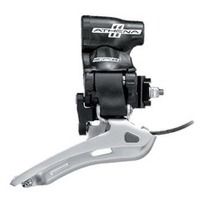-
Home
-
Contributors
-
International
-
Account
-
Information
More From Contributor
- longer component life. Ultra-shift (tm) Exclusive Geometry Parallelogram: maximum shifting rigidity, fast actuation, precision, friction reduction. Holed Cage Plate For Lower Weight: lighter Special Rubber Pulleys: reduced friction
- less noise ...
Specification above & just add to cart ...
- brake pads orbital adjustment
- lightened rear brake
- skeletonized arms
- special pad compound Skeleton structure differentiated front & rear levering orbital pad adjustment lightened Skeleton structure Weight: 299 g The nominal weight does not take account of the sometimes considerable quantities of grease used in the assembly of the products. ...
- One Action: The Eps system Control levers are positioned & act according to the same logic as Campagnolo mechanical gear levers. ...
Campagnolo Eps Athena 11x Front Mech
engineering polymer of the body of the derailleur. This creates optimal solidity and rigidity ensuring that the derailleur maintains a correct position with respect to the frame. The core of the derailleur is composed of an electronic actuator; in turn composed of a gear motor with a built-in resolver that uses Magnetic Hall Sensor technology (as the sensor is not in contact it is not affected by the vibrations generated by the terrain, and is therefore always precise). The gear motor was developed in partnership with a Swiss company that produces electric motors used in missions to Mars. The actuator is also equipped with a ""cascade gearbox"" which allows movement to be transferred in an exact and rapid manner. Automatic Correction: Compared to the traditional mechanical derailleur that
could be adjusted with micro displacements made by acting on the levers manually, the Eps derailleur is equipped with a very sophisticated electronic Automatic Position Correction system. Dti: Digital Tech Intelligence is housed inside the Power Unit and it continuously monitors the signals that arrive from all the Eps components, thus managing their operation. Water Proof: In order to achieve the Ip67 classification, all the electronic components of the Eps system underwent a series of tests, which proved their ability to function perfectly under one meter of water for at least 30 minutes.
- Availability: In Stock
- Supplier: Vanilla Bikes
- SKU: 1962773
Product Description
The Campagnolo Eps drivetrain is an organic set of mechanical & electronic components that work together in an integrated way to guarantee maximum performance. In particular, the Eps derailleur interacts with the mechanical crank set & enhances the elevated derailleur speed & precision made possible with X.p.s.s. technology. The 8 special upward zones & 2 downward zones for the chainrings associated to the speed & precision of the new Eps derailleur guarantee top performance. The derailleur is composed of a mechanical structure with dropout & a series of electronic parts. The outer Derailleur Rod held in place by a double-finned pin that passes all the way through to increase rigidity. The System that links the derailleur to the frame is made from aluminium co-pressed with the engineering polymer of the body of the derailleur. This creates optimal solidity & rigidity ensuring that the derailleur maintains a correct position with respect to the frame. The core of the derailleur is composed of an electronic actuator; in turn composed of a gear motor with a built-in resolver that uses Magnetic Hall Sensor technology (as the sensor is not in contact it is not affected by the vibrations generated by the terrain, & is therefore always precise). The gear motor was developed in partnership with a Swiss company that produces electric motors used in missions to Mars. The actuator is also equipped with a ""cascade gearbox"" which allows movement to be transferred in an exact & rapid manner. Automatic Correction: Compared to the traditional mechanical derailleur that could be adjusted with micro displacements made by acting on the levers manually, the Eps derailleur is equipped with a very sophisticated electronic Automatic Position Correction system. Dti: Digital Tech Intelligence is housed inside the Power Unit & it continuously monitors the signals that arrive from all the Eps components, thus managing their operation. Water Proof: In order to achieve the Ip 67 classification, all the electronic components of the Eps system underwent a series of tests, which proved their ability to function perfectly under one meter of water for at least 30 minutes.
Reviews/Comments
Add New
Intelligent Comparison
We couldn't find anything!
Perhaps this product's unique.... Or perhaps we are still looking for comparisons!
Click to bump this page and we'll hurry up.
Price History
We couldn't find any historical pricing!
Vouchers
Do you know a voucher code for this product or supplier? Add it to Insights for others to use.


 United Kingdom
United Kingdom
 France
France
 Germany
Germany
 Netherlands
Netherlands
 Sweden
Sweden
 USA
USA
 Italy
Italy
 Spain
Spain











 Denmark
Denmark